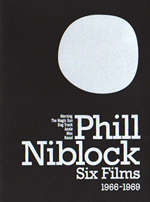|
|
 |
Dusted Reviews
Artist: Phill Niblock Album: Six Films 1966-1969 Label: Die Schachtel Review date: Jun. 22, 2010 |

|
|
|
 |
Niblock has put out so much recorded music and maintained such a busy concert schedule over the last decade that the films he projects at his concerts can be taken as inessential adjuncts to the sounds. But in the 1960s, when the six short films on this DVD were made, Niblock was only known as a photographer and experimental filmmaker. While its release corrects the distortion that Niblock is mainly an audio artist, it also begs consideration of what he does when he puts sound and image together.
Niblock’s films are just as distant from commercial moviemaking as the long drones of his music are from popular music; the ones collected on this DVD maintain a similar distance from the Movement Of People Working series that comprises his current in-concert fare. While his music focuses quite narrowly upon the possibilities inherent in a couple concerns — the juxtaposition of held tones and the interaction between sound and space — his film work takes a broader view. The People Working movies are, like his music, concerned with action that occurs over a span of time, and since they have no soundtrack of their own they are well suited to accompanying his recordings.
“Morning” and “Dog Track,” from this DVD, are both quite short, and each considers how sound and video tracks can support or contradict each other. The former follows several denizens of New York’s theater world and their acquaintances through some random morning encounters, and contrasts their internal dialogues with onscreen depictions of morning dressing, on-street conversation, and a backrub — all of which show that there’s a lot more to a picture than meets the eye. The latter contrasts lengthy takes of mostly sped-up urban and rural scenes with a woman’s reminiscences of childhood sexual experiences with pets and farm animals. The prurient soundtrack quite overwhelms the visuals, which demonstrates the power of sexualized and taboo material to overwhelm whatever it’s paired with, but also limits the appeal for repeat viewing to those who really get off on tales of girl-on-dog action.
The other four films are artist portraits. “Raoul” shows painter Raoul Middleman at work. Time-lapse photography protects you from the full boredom of seeing a guy daub paint and push charcoal while nude models pose in the studio or on the grass. But being privy to the making of a painting doesn’t necessarily enhance the experience of seeing the finished work anymore than you’d like Rumors better just because you have the VH1 documentary. The soundtrack, a murkily recorded conversation between Middleman and Niblock, brings no more light to the matter. This one’s mainly for Middleman fans. “Annie” shows dancer Ann Danoff walking Mary Tyler Moore-like through the city, moving from place to place, and in extreme close-up. Without having seen her dance, it’s hard to say if the film says anything about her art; the camera’s appreciative gaze upon her facial features and her movements through a meadow might, however, probably say something about the cameraman’s affection for its subject and invite you to like her, too. “The Magic Sun” is both a formal tour-de-force and an unconventional but entirely successful depiction of what made Sun Ra and his Arkestra unique back in the day. First negative images of Ra and other musicians in extreme close-up show their total otherness without compromising their charisma. Then the camera closes in so that the screen is mostly black, with white shapes flashing and leaping as violently and abstractly as the music, which is sourced from various Saturn LPs. You could listen to any three or four contemporary Ra records and not grasp so completely the mind-melting psychedelic quality of his music as you will by watching this movie. And “Max” is just as great at getting to the heart of composer and percussionist Max Neuhaus’s gifts without subscribing to the conventions of talking head commentary, voice-over or concert documentation. Sped-up, slowed-down, and layered close-ups of Neuhaus’s mallets at play upon his instruments capture the force and movement of his music, while the un-synchronized soundtrack (mostly metallic rumble and feedback) outs him as an early pioneer in the insinuation of noise into music.
The DVD’s package is, as you’d expect from Die Schactel, attractive but not overpowering. It is, however, bafflingly short on annotation. Some context-establishing discussion of Niblock’s film work would be nice, but instead there’s just a reprint of an article from 1974 issue of Sight Lines magazine that mostly discusses films that aren’t on the DVD, which only serves to raise the question of why they weren’t included.
By Bill Meyer
|







